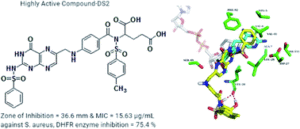We are very pleased to introduce Dr Mahmood Ahmed, one of the corresponding authors of the paper ‘Folic acid-sulfonamide conjugates as antibacterial agents: design, synthesis and molecular docking studies‘. His article has been very well received and handpicked by our reviewers and handling editors as one of our November HOT articles. Mahmood told us more about the work that went into this article and what he hopes to achieve in the future. You can find out more about the author and his article below and find more HOT articles in our online collection.
Meet the author
 Mahmood Ahmed received his M.Sc. (2003), M.Phil. (2013) and PhD (2018) degrees in Chemistry from Institute of Chemistry, University of the Punjab, Lahore-Pakistan. Currently he is working in Renacon Pharma Limited as Head Plant Operations. During his doctoral studies, he synthesized curcumin analogs and studied their various biological activities including antimicrobial and enzymatic inhibition. His research interest involve synthesis of novel drug analogs and tested them for various pharmacological properties against different phenotypes of various disease models. His research has resulted in the publication of 77 peer‐reviewed articles over 471 citations and h index = 14 and also he has reviewed 178 research articles for 37 international referred journals.
Mahmood Ahmed received his M.Sc. (2003), M.Phil. (2013) and PhD (2018) degrees in Chemistry from Institute of Chemistry, University of the Punjab, Lahore-Pakistan. Currently he is working in Renacon Pharma Limited as Head Plant Operations. During his doctoral studies, he synthesized curcumin analogs and studied their various biological activities including antimicrobial and enzymatic inhibition. His research interest involve synthesis of novel drug analogs and tested them for various pharmacological properties against different phenotypes of various disease models. His research has resulted in the publication of 77 peer‐reviewed articles over 471 citations and h index = 14 and also he has reviewed 178 research articles for 37 international referred journals.
Could you briefly explain the focus of your article to the non-specialist (in one or two sentences only) and why it is of current interest?
By developing new conjugates by different pharmacophores containing pteridine ring and sulfonamides in one structure, we are hoping to obtain new compounds of significant biological activity that might suppress the resistance mechanism of microorganisms.
How big an impact could your results potentially have?
Most of the conjugates have shown a similar or higher binding affinity with DHFR enzyme as compared to standard drugs and thus can be used to design better antimicrobial agents. Further molecular docking studies explain that the synthesized compounds are binding at the trimethoprim active site in DHFR the enzyme, which can help designing molecules with increased activity.
Could you explain the motivation behind this study?
As folic acid (FA) has a pteridine ring and an amino group, its conjugation with the sulfonyl group forms a scaffold containing both pteridine and sulfonamide, which confers better antibacterial activities targeting the anti-folate pathway.
In your opinion, what are the key design considerations for your study?
The compounds containing pyrimidine, pteridine, and azines moieties are good DHFR inhibitors.
Which part of the work towards this paper proved to be most challenging?
The synthesis of these conjugates and assuring their purity.
What aspect of your work are you most excited about at the moment?
The experimental data is well supported by molecular docking studies.
What is the next step? What work is planned?
The next plan is to do in vivo experiments and perform cytotoxicity activity studies.
Folic acid-sulfonamide conjugates as antibacterial agents: design, synthesis and molecular docking studies
Shabnam Shahzad, Muhammad Abdul Qadir, Mahmood Ahmed, Saghir Ahmad, Muhammad Jadoon Khan, Asad Gulzar and Muhammad Muddassar
RSC Adv., 2020,10, 42983-42992
DOI: 10.1039/D0RA09051D, Paper
 Submit to RSC Advances today! Check out our author guidelines for information on our article types or find out more about the advantages of publishing in a Royal Society of Chemistry journal.
Submit to RSC Advances today! Check out our author guidelines for information on our article types or find out more about the advantages of publishing in a Royal Society of Chemistry journal.
Keep up to date with our latest HOT articles, Reviews, Collections & more by following us on Twitter. You can also keep informed by signing up to our E-Alerts.











